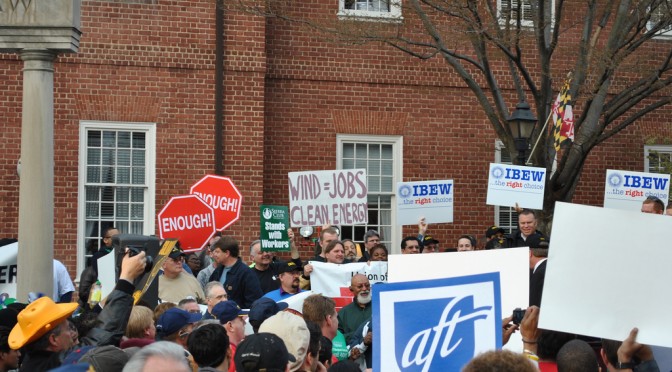By Eduardo Rosario
What is the history of the coalition between the labor movement and the environmental justice movement? To answer that question, I looked at labor’s activities on environmental issues in three time periods: 1948 to 1972, 1973 to the 1990s, and the 1990s to the present.
The labor movement took the lead on many environmental concerns between 1948 and 1972, because of the space labor occupied and the resources it mustered. Labor led the charge on such environmental concerns because the environmental justice movement was far smaller and did not command the level of resources labor possessed. With the relative economic prosperity of this time period U.S. labor was able to be inclusive of broader social justice issues such as the environment.
In the second period after 1973, facing massive job losses, labor shifted its priorities away from broader social concerns like the environment and began to take a more concessionary posture in collective bargaining. Economic pressures made union and non-union members alike feel vulnerable, and corporate America seized the opportunity.
In the third period, from the 1990s to the present, the discourse of labor versus the environment was still prevalent but labor and environmental coalitions (also known as blue/green coalitions) created an environmental justice framework that is helping both movements to overcome the class divide that traditionally divided them. Labor and environmental coalitions are placing the question of securing the necessities of life at the heart of environmental action.
This comparative historical analysis exposes the conditions under which blue/green coalitions emerge. I believe that coalition building is affected by economic and political conditions, but these same economic/political conditions and impositions can be trumped over time by education and lessons learned from the past. This is indisputable when we examine the mass mobilizations of the 1990s such as the Battle of Seattle, Occupy Wall Street, and the present day Blue/Green Alliance.
Coalition building between the labor and environmental movements may seem elusive, but will prove imperative if global capital continues to maintain its current trajectory, a course that will only lead to even greater environmental degradation, in turn, further exacerbating global economic conditions. The trade union principles of justice and dignity are not in conflict with the principles of social movement environmentalism. In unity, these social forces are in a stronger position combating the impositions of global capital than either of them can do alone.
Regardless of whether one favors an organizing model or a servicing/business unionism model, organized labor must address the heated debate surrounding the question of “jobs versus the environment”. Labor’s potential for growth, and its relevance as a social force are enhanced, particularly among youth and communities in need, when it takes up environmental issues. When labor does not take the steps necessary to be inclusive of broader social concerns these same communities are unlikely to view labor unions as a vehicle for improving their living and social conditions. For these reasons many labor activists embrace a social environmental perspective rather than following global capital’s market-based green economy and the business environmental agenda. The labor movement is beginning to gain a serious understanding of truths outside its familiar terrain, such as those from science, and is actively engaging in the fight against global warming.
The labor movement must continue to do so for a science-based climate change policy is very much the order of the day. An important step we all can take to help build a formidable movement in making this a reality is by mobilizing on the street during the “People’s Climate Change March” this September 20 – 21, 2014 – and by joining us at the upcoming planning meeting, July 1st 6pm, 66 West 12st.
Eduardo Rosario recently completed his masters in Labor Studies at the Murphy Institute



